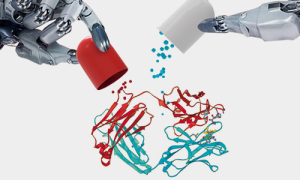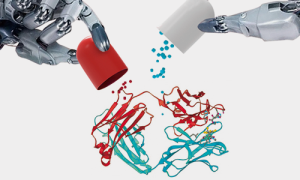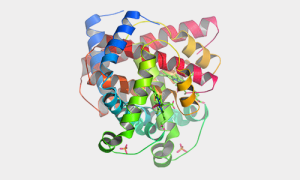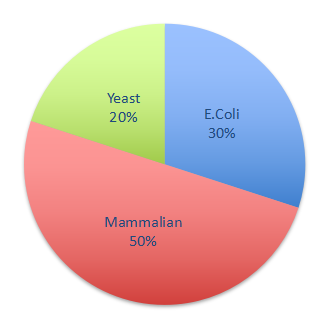Protein expression is the process by which a protein is produced in a cell. It involves the transcription of the protein’s coding sequence into mRNA, followed by the translation of that mRNA into protein. various intracellular and extracellular factors can influence protein expression, including the cell’s age, growth phase, and environment. In recent years, protein expression has been used increasingly in research and medicine. Recombinant protein expression technology is now widely used to produce proteins for use in life sciences, medicine, and other fields. This technology offers a number of advantages over traditional protein production methods, including shorter production times, higher purity levels, and lower costs. As a result, the demand for recombinant protein expression systems is increasing rapidly.

|

|

|

|
| Antibody Drugs | Structural Studies | Cell Culture | Tool Enzymes |
Comparison of recombinant and naturally derived proteins
| Recombinant Proteins | Naturally derived proteins |
|---|---|
| A recombinant protein is a protein obtained by applying recombinant DNA or recombinant RNA technology. More specifically, gene fragments of target proteins are obtained by recombinant technology, and then introduced into suitable host cells for expression and purification to obtain specific recombinant proteins. | It exists in nature and is not artificially modified or processed. |
| The host cells used for the production of recombinant proteins are mainly bacteria (E.coli), mammalian cells, insect cells and yeast. | Extracted from animal tissue. |
| High purity and activity of recombinant protein | Low Content |
| Using recombinant technology, recombinant proteins can be obtained in large quantities. Larger production means greater product consistency and low batch-to-batch variation. | High batch-to-batch variation. |
Host Utilization Rate in the Biopharmaceutical Field
Biopharmaceuticals are inseparable from cellular expression systems. 50% of the market for biotechnology products is taken up by mammalian protein expression systems, which are commonly used in the research, development, and production of biotechnology products. E. coli is another widely used protein expression system. As the preferred host for the expression of small molecule cytoplasmic proteins or structural domains, 30% of the recombinant proteins on the market are produced by E. coli expression systems. Yeast expression systems are eukaryotic protein expression system, accounting for about 20% of the market. These systems can successfully achieve intracellular or secretory expression, and its medium for amplification is better than other types of protein expression systems. Baculovirus insect cell expression is a process that is growing in popularity. It is not the most common way to produce proteins, but it has been gaining attention over the last few years.


Common Problems and Optimization Measures for Recombinant Proteins
Q1. What should I do if I have low recombinant protein expression?
We can improve the expression by optimizing the vector promoter, adjusting the transfection ratio, and changing the expression cells.
Q2. What should I do if the recombinant protein is easily degraded?
Sometimes, the host bacteria will break down your protein. We can solve this problem by changing which bacteria are used in production and optimizing culture conditions for them.
Q3. What should I do if the recombinant protein is aggregated?
We suggest selecting an appropriate cell lysis and fragmentation method for our buffer system to cope with it.
Q4. What should I do if the recombinant protein suffers from nucleic acid contamination?
When the target protein has a nucleic acid binding activity, it can cause contamination by releasing more of its own DNA. This problem could be solved with an extra step in cell preparation and/or using nuclease after fragmentation for intracellular expression products.
Recombinant Protein Expression | Synbio Technologies
The goal of our company is to provide the best services possible. We have been doing this for years and are experts in what we do! Our success rate far exceeds 95%. In addition, all proteins generated by us will be high quality with purity rates well over 90%. Furthermore if you’re looking for a specific type or amount then don’t worry because four major platforms allow us generate any amount imaginable from milligrams up onto grams.
Our team enjoys problem-solving. If you have questions, we will help you find the answers!
 DNA Synthesis
DNA Synthesis Vector Selection
Vector Selection Molecular Biology
Molecular Biology Oligo Synthesis
Oligo Synthesis RNA Synthesis
RNA Synthesis Variant Libraries
Variant Libraries Genome KO Library
Genome KO Library Oligo Pools
Oligo Pools Virus Packaging
Virus Packaging Gene Editing
Gene Editing Protein Expression
Protein Expression Antibody Services
Antibody Services Peptide Services
Peptide Services DNA Data Storage
DNA Data Storage Standard Oligo
Standard Oligo Standard Genome KO Libraries
Standard Genome KO Libraries Standard Genome Editing Plasmid
Standard Genome Editing Plasmid ProXpress
ProXpress Protein Products
Protein Products
























